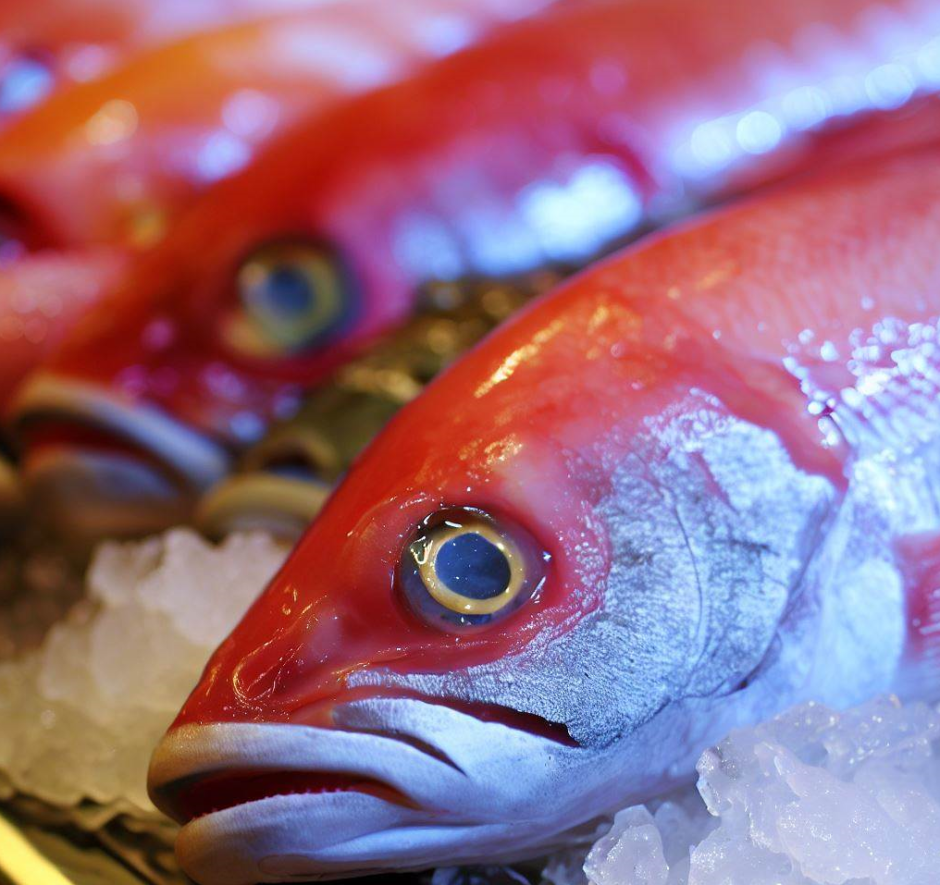 なおえもん
なおえもん
Hi there.I’m Naoemon.
Have you ever wondered why Japanese fish is so fresh and delicious? Japan is an island nation surrounded by the sea and has long had a culture of eating fish. However, freshness is the key to fish. From the moment the fish dies, its taste and texture are lost due to oxidation and bacterial action. Therefore, various techniques and innovations have been used in Japan to keep fish fresh. This article introduces some of the techniques used to keep fish fresh in Japan.
Speed from catch to processing
The freshness of fish is greatly affected by the time between catch and processing. From the moment the fish dies, taste and texture are lost due to oxidation and bacterial action. Therefore, processing fish as soon as possible after they are caught is fundamental to maintaining freshness.In Japan, a variety of fishing methods are used, among which methods such as single line fishing and gill nets allow fish to be pulled out quickly without damaging them. These fishing methods not only keep fish fresh, but also facilitate resource conservation and sorting.
Fish caught are also preserved on board using ice water or vacuum packing. Ice water lowers the body temperature of the fish, thereby reducing oxidation and bacterial growth. Vacuum packing prevents oxidation by preventing exposure to air.
In addition, modern freezing technology and distribution systems are also important for keeping fish fresh. Refrigeration technology freezes fish at low temperatures and at high speeds to retain moisture and nutrients without destroying the fish cells. Distribution systems prevent quality deterioration by transporting, storing, and selling frozen fish under appropriate temperature control.
As described above, various technologies and innovations are used in Japan to speed up the process from catch to processing. These technologies and innovations have been developed to meet the Japanese people’s high demand for freshness in fish.
Fishing methods such as single line fishing and gill nets
One factor that affects the freshness of fish is the fishing method. Fishing methods are the tools and methods used to catch fish. Different fishing methods cause different amounts of damage and stress to the fish. The less damage and stress, the fresher the fish.In Japan, fishing methods such as ippon tsuri-guri and gill-netting are attracting attention for their ability to increase fish freshness. Ippon fishing is a fishing method in which large migratory fish such as tuna and bonito are caught one by one with a fishing rod. Gill nets are used to catch small migratory fish such as horse mackerel and mackerel by entangling them in a strip-shaped net.
The characteristics of these fishing methods are as follows
- Can be pulled up quickly without damaging the fish.
- Can sort fish by species and size.
- Catch can be adjusted.
- Minimal impact on water pollution and ecosystems
Fish caught by these fishing methods also differ in appearance and taste. Fish caught by single hook and line or gill nets have beautiful golden bodies. This is evidence that they died in a stress-free state. Stress-free fish have more glycogen remaining in their muscles, which turns them golden brown when grilled. Glycogen is also a sweetener and makes the fish taste sweeter.
As described above, fishing methods such as single line fishing and gill netting not only keep the fish fresher, but also provide fish with a superior appearance and taste. These fishing methods have evolved to satisfy the Japanese people’s high standards for fish.
Storage methods such as ice water and vacuum packing
Another factor that affects the freshness of fish is the method of preservation. Storage methods refer to how the fish is kept fresh after it is caught. The quality and taste of the fish also depends on the preservation method.In Japan, preservation methods such as ice water and vacuum packing are gaining attention as ways to keep fish fresh. Ice water is a preservation method in which small fish such as horse mackerel and mackerel are immersed in cold water made of seawater and ice. Vacuum packing is a preservation method in which large fish such as tuna and bonito are sealed in airtight bags.
The characteristics of these preservation methods are as follows
- They keep the fish fresher by lowering its body temperature.
- Prevents spoilage by reducing contact with bacteria and oxygen on the fish.
- Retain water and nutrients in the fish without losing them.
- The color and shape of the fish can be kept unchanged for a more beautiful appearance.
Fish preserved with these preservation methods also differ in the way they are prepared. Fish preserved in ice water is better suited for raw dishes such as sashimi and sushi. Ice water preservation tightens the muscles of the fish, increasing its texture and flavor. Vacuum-packed fish is suitable for cooking over heat, such as **stewed or grilled**. Vacuum packing preserves the water and nutrients in the fish, making it tender and juicy.
As described above, preservation methods such as ice water and vacuum packing not only increase the freshness of fish, but also provide fish with superior cooking methods and taste.
Modern refrigeration technology and distribution systems
Another factor that affects the freshness of fish is freezing technology and distribution systems. Refrigeration technology is the process of freezing and preserving fish at low temperatures. The distribution system is the process from the time the fish is caught to the time it reaches the consumer. The quality and taste of fish vary depending on the freezing technology and distribution system.In Japan, modern freezing technology and distribution systems are attracting attention as they enhance the freshness of fish. Modern freezing technology includes high-quality freezing and distribution technology and fish live boxes. High-quality freezing and distribution technology is a technology to produce high-freshness frozen products by controlling ATP concentration; ATP is an energy substance in muscle that stabilizes proteins and keeps them fresh when remaining after death. Fish Live Box is a technology for transporting live fish. Live fish are placed in special boxes to regulate air and water temperatures, keeping them fresh over long distances.
These refrigeration technologies and distribution systems are characterized by the following features
- The fish’s body temperature is lowered to maintain freshness.
- Reducing contact with bacteria and oxygen on the fish to prevent spoilage.
- Can retain water and nutrients in the fish without losing them.
- The color and shape of the fish can be kept unchanged for a more beautiful appearance.
Fish preserved with these freezing technologies and distribution systems also differ in the way they are prepared. Fish preserved with high-quality freezing and distribution technology is better suited for raw dishes such as sashimi and sushi. Fish preserved with high quality freezing and distribution technology remains high in ATP concentration, increasing its crunchiness and flavor. Fish preserved in the Fish Live Box is suitable for cooking over heat, such as simmered or grilled dishes. Fish preserved in fish-live boxes are transported alive, resulting in a tender and juicy texture.
As described above, modern refrigeration technology and distribution systems not only increase the freshness of fish, but also provide fish with superior cooking methods and taste.
How to keep fish alive and handle it
Another factor that affects the freshness of fish is how the fish is kept alive and handled. How fish are kept alive is the process of keeping fish alive after they are caught. Fish handling is the process from killing the fish to cooking it. The quality and taste of fish vary depending on how the fish is kept alive and handled.In Japan, traditional methods of fish preservation and handling are emphasized as they enhance the freshness of fish. Traditional methods of fish preservation include katsumejime and katsumejime storage. Seikishime is a method in which the fish is bled and gutted before being placed in ice water. Removing the blood and entrails removes the cause of bacteria and odor, and placing the fish in ice water lowers its body temperature to keep it fresh. Seikishime storage is a method of preserving fish by placing them in an aquarium after seikishime. Placing the fish in an aquarium delays rigor mortis and preserves tenderness.
Traditional methods of handling fish include triplating and drying overnight. Three-piece grating is a method in which the head and tail are cut off and then the fish is cut from the back to the belly. By triplating the fish, the skin and bones are removed to make it easier to eat, season, and cook. Overnight drying is a method of drying the fish overnight after sprinkling it with salt. Overnight drying removes water from the fish, concentrating its flavor and increasing its aroma and texture.
The characteristics of these methods of making the best use of and handling the fish are as follows.
- Keeps fish fresh and tender longer.
- Reduces fish odor and bacteria, making the fish more hygienic.
- It can bring out the flavor and aroma of fish.
- Improves the palatability and appearance of fish.
Fish preserved in these ways of living and handling also differ in the way they are prepared. Live-fish is suitable for raw dishes such as sashimi and sushi. When fish is kept alive, it is bled and gutted to remove odors and kept fresh in ice water. Fish kept in the live-fish tank are suitable for cooking over heat, such as simmered or grilled dishes. When kept alive, rigor mortis is delayed in the tank and tenderness is preserved. Fish that are cut into three pieces are suitable for deep-frying dishes such as tempura and fried fish. When three-ply, the skin and bones are removed, making it easier to season and coat the fish. Overnight dried fish is suitable for cooking dishes such as grilled fish and cooked rice. Drying fish overnight reduces the water content and concentrates the flavor.
As described above, Japanese methods of utilizing and handling fish not only enhance the freshness of fish, but also optimize the characteristics of the fish and its preparation. These methods have been integrated into the Japanese fish-eating culture and have been passed down to the next generation as a way to bring out the best in fish.
How to process fish, such as live-treatment and bleed-out
To keep fish fresh, it is important to use processing methods such as kizume-shime and bleed-draining. Seikishime is a method of delaying rigor mortis by severing the brain and spinal cord of the fish to stop the nerves. Draining the blood from the fish is a method of preventing the blood remaining in the fish’s flesh from oxidizing and causing odor and fading. These processing methods vary depending on the type and size of the fish, but the basic steps are as follows- Live-steering: First, the nerves are stopped by either piercing the brain behind the fish’s eyes or by entering through the mouth and cutting the medulla oblongata. This allows the fish to die without suffering. Next, the spinal cord is severed by passing a wire from the base of the dorsal fin to the tail fin. This stops muscle contractions.
- Drain the blood: Next, cut the gills in one place by inserting scissors or a knife into the gills. The heart is left in place. This allows the heart to beat and the blood to flow out easily. Submerge the fish in seawater or tap water and wait until it stops bleeding.
- Ice-tightening: Finally, place the fish in a cooler box or other container filled with tide ice. Ice-fastening tightens the fish’s flesh.
Cooking Methods such as Ikizukuri and Sushi
Fish that have been processed by such methods as kizukime and bleed removal can be served as katsuyazukuri or sushi. Kizukuri is a method of serving fish alive as sashimi to enjoy the freshness and texture of the fish. Sushi is a way to enjoy the taste and flavor of fish by placing or rolling fish or seaweed on vinegared rice. These cooking methods vary depending on the type of fish and your preference, but the basic steps are as follows- Ikizukuri: First, cut the fish into three pieces and remove any small bones. Next, cut the fish into thin slices with a sashimi knife and place them on a plate. Finally, the head and tail of the fish are skewered and placed on a plate. This makes the fish appear alive.
- Sushi: First, rice is cooked and mixed with sushi vinegar to make sushi rice. Next, the fish is cut and seasoned with salt or vinegar, or tightened with kombu (kelp). Finally, the fish is hand-rolled or rolled in seaweed to make sushi.
How to choose the season, place of production, etc.
To enjoy the taste of fish, it is important to know its season and place of production. Season refers to the time of year when fish is at its most delicious, and varies depending on the type of fish and its region of origin. Place of production refers to where the fish is caught, and the water temperature and quality of the water affect the taste and quality of the fish. Knowing the season and place of production will help you choose the characteristics of the fish and the recommended way to eat it. Below are examples of seasonal fish and their production areas by season.- Spring: Spring is the season for migratory fish and whitefish. For example, Spanish mackerel is in season in spring in the Seto Inland Sea and is served with mako or albacore. Flounder is also in season in Hokkaido and Tohoku in spring and is suitable for simmered or dried fish.
- Summer: Summer is the season for bluefish and shellfish. For example, horse mackerel is in season throughout Japan in summer and is served as sashimi or fried. Clam is also in season in Tokyo Bay and the Seto Inland Sea in summer and is suitable for soup and steamed dishes.
- Autumn: Autumn is the season for high-end and deep-sea fish. For example, tuna is in season in Sanriku and Tokyo Bay in autumn, and is served as O-toro (fatty tuna) or Chutoro (medium fatty tuna). Anglerfish is also in season in Hokkaido and the Tohoku region in autumn, and is suitable for nabe (hot pot) with liver and milt.
- Winter: Winter is the season for yellowtail and crab. For example, yellowtail is in season in Toyama Bay and the Noto Peninsula in winter, and is suitable for sashimi and teriyaki because of its high fat content. Crabs are also in season on the Sea of Japan side in winter and can be boiled or grilled.
Summary
The secret to the freshness and deliciousness of Japanese fish lies in the speed with which the fish is caught and processed, as well as in the way they are kept alive and handled. In Japan, various techniques and innovations have been used to keep fish fresh. These techniques and innovations are also an expression of the Japanese food culture and aesthetic sense. When you taste Japanese fish, you should also feel the history and culture behind it.0



コメントを残す